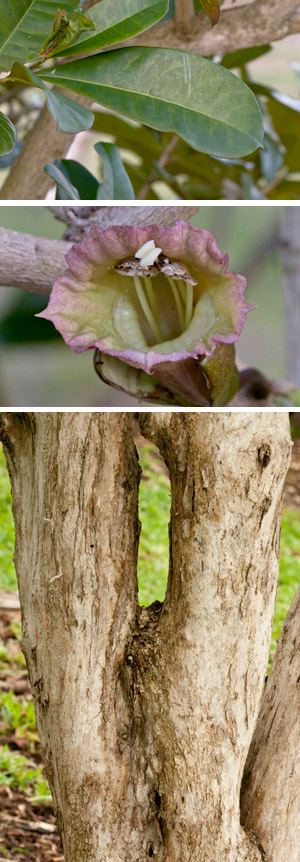|
Amphitecna latifolia
Cocoa, Higüerillo, Higüerita / Black calabash
|

Copyright by: Keith Bradley
Família/Family: Bignoniaceae
Grupo/Group: Dicotiledónea/Dicotyledon.
Forma de vida/Life form:
Árbol/Tree
Duración de vida/Lifespan:
Perenne/Perennial.
Sustrato/Substrate:
Terrestre/Terrestrial.
Distribución nativa/Native range:
Indias Occidentales (Antillas Menores, Antillas Mayores), Sur de Florida, sur de México, Centroamérica y norte de Sudamérica. / The West Indies (Lesser Antilles, Greater Antilles), South Florida, southern Mexico, Central America and northern South America.
Mapa de ubicaciones / Map of locations
|
| ESTATUS EN LA ISLA DE PUERTO RICO/STATUS ON THE ISLAND OF PUERTO RICO |
Presencia/Occurence:
Presente/Present.
Origen/Origin:
Nativo/Native.
Historia y distribución/History and distribution:
Un árbol raro, disperso en elevaciones bajas. Principales regiones geográficas conforme a Axelrod (2011): Calizas Costeras del Sur (Bosque Estatal de Guánica), Cordillera Occidental (Bosque Estatal de Susúa), Llanuras Costeras del Norte, Colinas Calizas del Norte (Ciales). Áreas botánicamente únicas conforme a Axelrod (2011): ninguna. En bosques, a lo largo de bancos de arroyos, en laderas y dunas costeras en elevaciones bajas en distritos húmedos cerca de la costa, en las zonas oeste y norte de la isla (Little et al. 1974, Liogier & Martorell 2000, Axelrod 2011). Monsegur Rivera (2009) la reportó para la Playa de Guánica (Gregory 313 UPR) en 1940, pero no fue encontrada en evaluaciones recientes en el Bosque Estatal. Tampoco hay registros recientes o especímenes del Bosque Estatal de Guajataca.
/
A rare tree scattered at low elevations. Major geographic regions following Axelrod (2011): Southern Coastal Limestone (Guánica State Forest), Western Cordillera (Susúa State Forest), Northern Coastal Lowlands, Northern Limestone Hills (Ciales). Botanically unique areas following Axelrod (2011): none. In woodlands, along stream banks, on hillsides and sand dunes at lower elevations in moist districts mostly near the coast, in the western and northern parts of the island (Little et al. 1974, Liogier & Martorell 2000, Axelrod 2011). Monsegur Rivera (2009) reported that it was collected at the Playa de Guánica (Gregory 313 UPR) in 1940, but was not found in recent surveys in the State Forest. There are also no recent reports or specimens from Guajataca State Forest.
|
| CONSERVACIÓN/CONSERVATION |
Global, estatus Lista Roja UICN/IUCN Red List status:
Aún no evaluado, pero en el Catalogue of Life/Not yet assessed, but in the Catalogue of Life.
Puerto Rico, estatus legal DRNA/DNER legal status:
No enlistado/Not listed.
Puerto Rico, lista de rastreo del DRNA 2007/DNER tracking list 2007:
Elemento crítico/Critical element.
Estatus preliminar del IRC para la isla de Puerto Rico (método del NatureServe 2012)/Preliminary IRC status for the island of Puerto Rico (NatureServe 2012 method):
En peligro/Imperiled.
Estatus preliminar del IRC para la isla de Puerto Rico (método regional de la Lista Roja de la UICN)/Preliminary IRC status for the island of Puerto Rico (IUCN Red List method):
Vulnerable.
Notas de Conservación/Conservation Notes:
Fue listada por primera vez como especie rara en Puerto Rico por Woodbury et al. (1975), quienes la clasificaron como una especie rara no endémica de Puerto Rico (especie No. 416). Fue listada como Elemento Crítico por el DRNA en 1988, 1999 y 2007. No fue incluida como una especie conocida de tres o menos localidades en Puerto Rico y las Islas Vírgenes por Figueroa Colon & Woodbury (1996) o por Figueroa Colon (1996).
/
This was first listed as a rare species in Puerto Rico by Woodbury et al. (1975), who classified it as a rare species not endemic to Puerto Rico (species No. 416). It was listed as a Critical Element by DNER in 1988, 1999 and 2007. It was not included as a species known from three or fewer locations in Puerto Rico and the Virgin Islands by Figueroa Colon & Woodbury (1996) or Figueroa Colon (1996).
|
| TAXONOMÍA/TAXONOMY |
Nombre científico con autores/Scientific name with authors:
Amphitecna latifolia
(Mill.) A.H. Gentry
Sinónimos/Synonyms:
Crescentia latifolia Mill., Enallagma latifolia (Mill.) Small.
|
|
|
ENLACES A PAGINAS EXTERNAS/LINKS TO EXTERNAL WEBSITES
|
|
|
|
Todas las Im�genes/All Images:
|

Copyright by: Keith Bradley
|
|
|


 Plantas de la Isla de
Plantas de la Isla de










